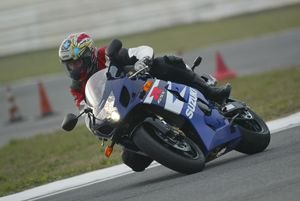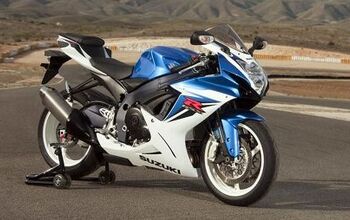2004 Suzuki GSX-R600 - Motorcycle.com
In a model year where the super-sporting crowd is bombarded with three new liter-class tools of the thickest caliber, a cool little 120 hp 600 such as the new GSX-R gets bumped out of the spotlight and into the shadows. There's no justice in this world, but what can a trim and sexy little girl do when she's confronted with a trio of 6' tall divas? Try walking on her hands to draw attention at the big party? During the Milan show, when everybody was busy guessing if the new biggies had indeed 180 or just 175 hp, it was easy to overlook the unassuming 2004 GSX-R 600. That's a shame really, if we journos would've paid attention to the small type, we would have noticed that the asphalt darling of many a 600 club racer got titanium valves this year, radial caliper brakes AND master
This total revamp hasn't come a moment too early. Last year saw the introduction of three new cutting edge 600's and even before their big splash, the GSX-R was looking already a bit anachronistic and ungainly. Although upgraded in 2001, the previous model leant heavily on the mid-90's architecture of the first GSX-R 750T. It had a bulbous presence between your legs, courtesy of those thick frame spars and a wide gas tank, a longish reach to low bars compounded by a high seat and an engine that was overshadowed when the R6 spoiled us with a 15,000 rpm redline in 99'.
Time to ride the thing around the famous SBK venue of Misano. It could have been a day to remember if it only wasn't end of January
Here we have the GSX-R1000... wait, scratch that.in the central Europe. The night before our test ride I had put three hours of driving through a wild snow storm from Milan to the Adriatic coast in the cheapest of rental cars (Sean, there wasn't even an AM radio!) while constantly asking myself: Why am I doing this, I'm not even an ice skater?! (Though I hear Sean likes to drive sideways in radioless rental cars) Luckily, the snow did not reach the coastal zone of Misano Adriatico and by 10:00 am of the next day, the light icing on the track had melted down while temperatures were up to slightly above freezing point. An outing on a wet track you'd never ridden on before on cold as stone tires is a daunting task to say the least, let alone actually track testing a frantic ss600. Yet, after a few laps, with some calories rubbed onto the tires, I had to admit I was enjoying myself. The friendliness with which the GSX-R 600 received me and the immediate confidence it inspires were remarkable. Where is the hard racer edge GSX-R's are known for? Forget about the extreme riding position of the old model. The new Gixxer is smack up to date ergonomic-wise with bars that are closer to the rider and a riding posture that is much more compact and modern, giving you a real possibility to raise your upper body while learning the way around. It's not CBR 600RR short but close while the extra narrowness between your knees and ankles is felt too.Then there's that engine. On my first tentative laps I wasn't really paying attention to the revs, but then it hit me, since when do you ride a 600 without caring much about engine revs? So it looks like Suzuki's claim for bumped up torque is for real and those zillion ignition maps must be doing their job right cause by 600 standards the GSX-R engine can almost be logged. Watch the video and see how the thing pulls out from turns from as low as 7000. In these harsh morning conditions the GSX-R was a doodle to ride while short shifting my way around this easy to learn track. It didn't take long to learn that the GSX-R is blessed with amazing tires too. Bridgestone's new generation BT014 S (S signaling a special version made for the GSX-R) were actually managing to grip well the cold and wet track and I kept finding myself generating more lean angle than I bargained for.
So far so good, by my second stint, (the one with the videocam on) it had started to drizzle but both riders and bikes seemed warmed up enough to up the pace. This leads us to the other face of THAT engine. With more confidence in grip I start to wring the thing's neck and the ease with which it shoot's up to 15K is amazing. Then in the short chutes between Misano's "Variantes" (chicanes in Italian), I found myself stretching the GSX-R mill to 16K , right up to the braking points accompanied by that awe inspiring shriek. Simply put, having an effective rev range that stretches from 8-16K is an extremely useful boon, one that is certainly important also on the street and not just on the track. So by 8000 engine is pulling nice and clean, at 12K things hike up and after 14K you can sense the power curve flattening out somewhat towards the 16K mark. This superb over revving capability saved me from quite a few time consuming, chassis upsetting gearshifts. Talking by seat of the pants, I wouldn't hesitate calling the GSX-R's mill the best current 600 engine, right there with the 636 mill in terms of flexibility but maybe even more enjoyable because of that sky high redline. We'll have to wait for MO's dyno final verdict though. Last mental note from this stint, when you have such a screaming top end, you can gear down things and eventually shorten gaps between gears and that its really how it felt, you had to be really trying to catch the engine off-guard. Even out side its effective rev range, the Suzuki trademark twin throttle butterflies setup, otherwise known as SDTV, supplied supreme response; something that was double appreciated in the precarious conditions.I dedicate my next stint to the cycle side.
While pumping up the forks and tail at stand still, damping and springing felt somewhat mushy in their standard settings. Not a bad setup for a damp track but as the day advanced things where drying and corner speeds were raising. Yet despite the increasing grip and accompanying side and braking forces, the Gixxer remained utterly composed and stable, even through mental Curvone turn (4a in the pic). It's the last in a chain of wide open left handers and by the time you approach it, already leaned more than halfway over, you need to kick in the bike harder still at close to 120mph while still rolling the throttle on. Damp patches and all, the GSX-R was gracefully hinting that the only limit was my chickening throttle hand. Not even a hint of tail wagging or weaving. Then, on the hardest braking bit of the track, before the Tramonto horseshoe, chopping off from 150 down to 70 mph the USD fork remained unfazed while still soaking up the irregularities of the tarmac. Only a few of the more skilled Italian journo-guns around were asking for extra preload and rebound damping at the front but that was it. Talking about braking, the new all radial setup is the bollocks. It might not have the outright initial bite of say the RSV Factory Brembo setup but it more than makes up for it with its superb feel while braking at the limit. When I started to get cocky in my fourth stint, going in too hot and muttering four letter words, I found that I could easily dial in the extra braking force needed to chop off the speed in controlled fashion. Lever response remained constant through my stints but it must be said that Misano is not terribly demanding on brakes.
More by Yossef Schvetz














![Inside Look at the 2011 Suzuki GSX-R600 [video]](https://cdn-fastly.motorcycle.com/media/2023/05/07/11554789/inside-look-at-the-2011-suzuki-gsx-r600-video.jpg?size=350x220)
















Comments
Join the conversation